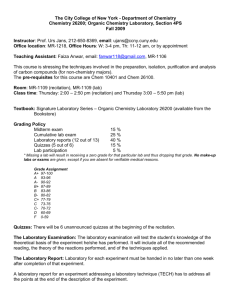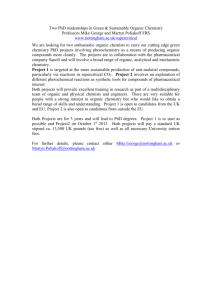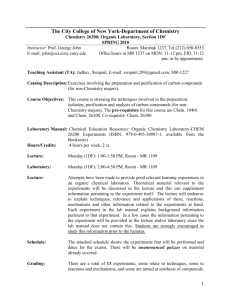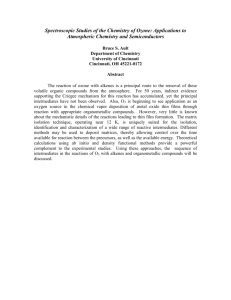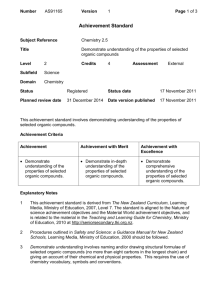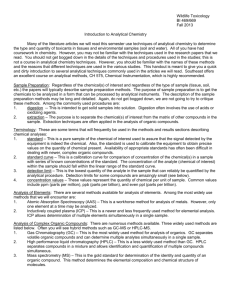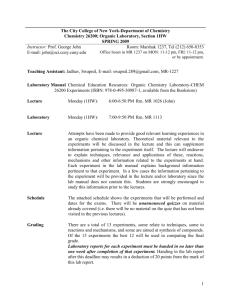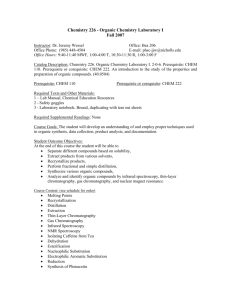Li - The City College of New York
advertisement
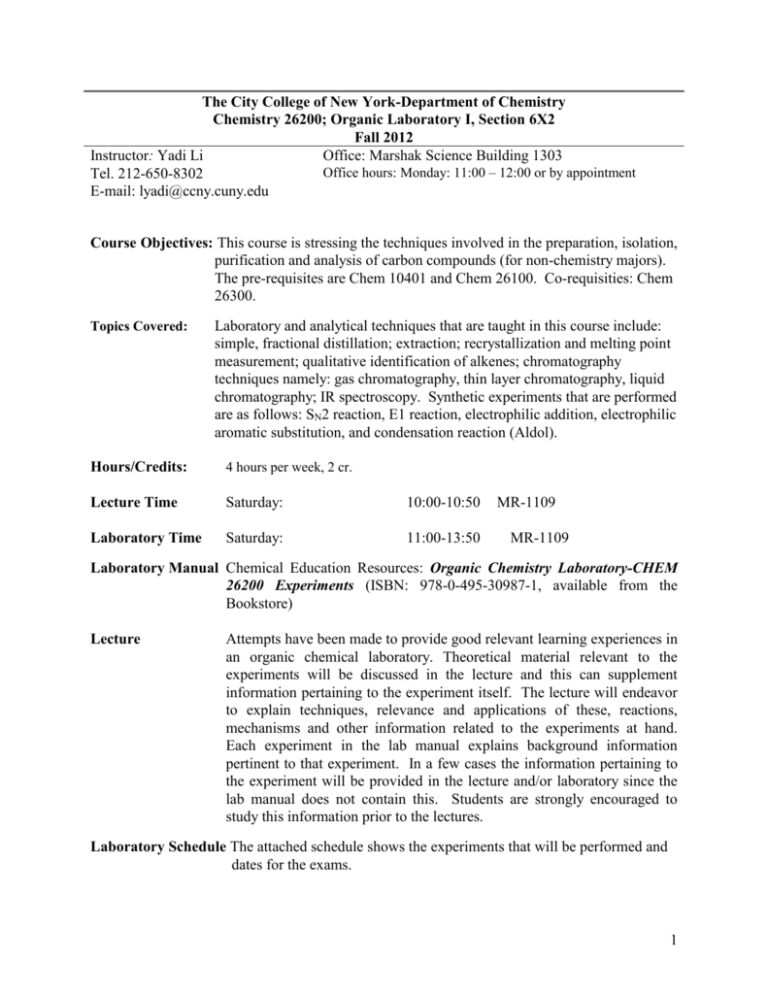
The City College of New York-Department of Chemistry Chemistry 26200; Organic Laboratory I, Section 6X2 Fall 2012 Instructor: Yadi Li Office: Marshak Science Building 1303 Office hours: Monday: 11:00 – 12:00 or by appointment Tel. 212-650-8302 E-mail: lyadi@ccny.cuny.edu Course Objectives: This course is stressing the techniques involved in the preparation, isolation, purification and analysis of carbon compounds (for non-chemistry majors). The pre-requisites are Chem 10401 and Chem 26100. Co-requisities: Chem 26300. Topics Covered: Laboratory and analytical techniques that are taught in this course include: simple, fractional distillation; extraction; recrystallization and melting point measurement; qualitative identification of alkenes; chromatography techniques namely: gas chromatography, thin layer chromatography, liquid chromatography; IR spectroscopy. Synthetic experiments that are performed are as follows: SN2 reaction, E1 reaction, electrophilic addition, electrophilic aromatic substitution, and condensation reaction (Aldol). Hours/Credits: 4 hours per week, 2 cr. Lecture Time Saturday: 10:00-10:50 Laboratory Time Saturday: 11:00-13:50 MR-1109 MR-1109 Laboratory Manual Chemical Education Resources: Organic Chemistry Laboratory-CHEM 26200 Experiments (ISBN: 978-0-495-30987-1, available from the Bookstore) Lecture Attempts have been made to provide good relevant learning experiences in an organic chemical laboratory. Theoretical material relevant to the experiments will be discussed in the lecture and this can supplement information pertaining to the experiment itself. The lecture will endeavor to explain techniques, relevance and applications of these, reactions, mechanisms and other information related to the experiments at hand. Each experiment in the lab manual explains background information pertinent to that experiment. In a few cases the information pertaining to the experiment will be provided in the lecture and/or laboratory since the lab manual does not contain this. Students are strongly encouraged to study this information prior to the lectures. Laboratory Schedule The attached schedule shows the experiments that will be performed and dates for the exams. 1 Grading There are a total of 13 experiments, some relate to techniques, some to reactions and mechanisms, and some are aimed at synthesis of compounds. Of the 13 experiments the best 12 will be used in computing the final grade. Laboratory reports for each experiment must be handed in no later than one week after completion of that experiment. There will be one mid-term exam (worth 75 points) and one final exam (worth 100 points). There will be 6 unannounced quizzes on material already covered (i.e. there will be no material on the quiz that has not been visited in the previous lectures) (each worth 10 points). The quizzes will be administered at the beginning of a lecture. Of these, the best 5 quiz grades will be used for calculation of the final grade. Student laboratory performance will be evaluated by the TA and is worth a total of 25 points. A summary of the points assigned to each portion of the course is shown below. Note that the exams and quizzes constitute ~40% of the grade while the laboratory activities constitute ~60%. Experiments 13 in all, best 12/13 x 25 points each Quizzes 6 in all, best 5/6 x 10 points each Mid-term exam, 75 points Final exam (comprehensive), 100 points TA evaluation, 25 points TOTAL POINTS FOR THE COURSE = 300 points = 50 points = 75 points = 100 points = 25 points = 550 points (100%) THERE ARE NO MAKEUP LABS AND NO MAKEUP EXAMS OR QUIZZES. ABSENCE WITHOUT A STRONG, VERIFIABLE, DOCUMENTED REASON WILL RESULT IN ZERO POINTS FOR THE MATERIAL MISSED. LAB REPORTS NOT SUBMITTED IN A TIMELY MANNER WILL ALSO RESULT IN ZERO POINTS FOR THAT EXERCISE. Safety issues You must wear lab goggles at all times in the lab. Do not wear shorts or short skirts without a lab coat; this is for your safety! Similarly, open shoes and slippers should not be worn. Do not eat, drink, or smoke in the laboratory. YOUR workplace should be CLEAN always! Breakage Students must be aware of the fact that they will be charged for the replacement cost of any equipment that they break during the lab course. Some of the glassware is especially expensive and so you are urged to work carefully at all times. If you have questions, comments or suggestions please contact you teaching assistant or the instructor. 2 Course Learning Outcomes for Chem 26200 1. To understand the physical principles underlying the techniques used for purification of compounds, separation of reaction mixtures, monitoring reactions and analyzing reaction products in organic chemistry lab. 2. Understand the mechanistic basis of synthetic experiments. 3. To learn and execute several fundamental organic laboratory techniques used. 4. To perform fundamental organic reactions. 5. To learn the safety precautions required in an organic lab. 6. To learn the calculations associated with synthetic organic experiments. 7. To learn how to make observations, collect data and write a lab report for an organic synthesis experiment. Academic Integrity: The CCNY policy on academic integrity will be followed. A document is posted on the CCNY website (CUNY policy on academic integrity: www1.ccny.cuny.edu/facultystaff/provost/upload/academicintegrity.pdf 2007-01-19). Make sure you have read the details regarding plagiarism and cheating, in case you are not clear about the rules of the college. Cases where academic integrity is compromised will be prosecuted according to these rules. 3 The City College of New York- Department of Chemistry Chemistry 26200-Organic Chemistry Laboratory I-Fall 2012 Section 6X2: Lecture: J1109: Sat. 10:00-10:50; Lab: J1109: Thu. 11:00-1:50 SCHEDULE AND (REVISIONS) OF EXPERIMENTS Week 1 Sep 1 Introduction, Check In, Measuring Melting Points of Compounds and Mixtures (Identifying an unknown compound by mixture melting point) TECH 701 Week 2 Sep 8 Purifying Acetanilide by Recrystallization (no solvent selection process--solvent is water) TECH 703 Week 3 Sep 15 Separating Cyclohexane and Toluene by Distillation (Macroscale, Fractional Distillation) TECH 704 Week 4 Sep 22 Separating Acids and Neutral Compounds by Solvent Extraction (Macroscale Extraction and the extraction mixtures are pre-prepared) TECH 705 Week 5 Sep 29 Separating Ferrocene and Acetylferrocene by Adsorption Column Chromatography (use dry pack method with microscale column/stationary phase—silica gel/eluent— hexane and ethyl acetate) TECH 708 Week 6 Oct 6 Gas Chromatography and Thin Layer Chromatography Handouts Week 7 Oct 13 Group 1: Brominating Alkenes (semi-microscale); Group 2: Identifying an Unknown Compound by Infrared Spectroscopy (known samples) TECH 719 TECH 710 MID-TERM EXAM Week 8 Oct 20 TECH 719 Group 1: Brominating Alkenes (semi-microscale); Group 2: Identifying an Unknown Compound by Infrared Spectroscopy (known sample) TECH 710 Week 9 Oct 27 Qualitative Test for Alkenes and Identifying an Unknown Compound by FT-IR/ATR REAC 472/Handout Week 10 Nov 3 Studying SN1 and SN2 Reactions: Nucleophilic Substitution at Saturated Carbon (Synthesizing 1-Bromobutane (SN2) using macroscale techniques) REAC 714 Week 12 Nov 10 Dehydrating Cyclohexanol (semi-microscale) REAC 712 Week 13 Nov 17 Nitrating Methyl Benzoate REAC 716 Week 14 Dec 1 The Aldol Condensation: Synthesis of Dibenzylacetone (semi-microscale) SYNT 720 Week 15 Dec 8 FINAL EXAM, Equipment Check Out - 4 Laboratory Report All your lab work should be recorded in a lab notebook and NOT on scraps of paper. Data recorded in the notebook must be properly dated, and neatly written. Based on this information, you will generate a laboratory report that will be submitted for grading. This exercise provides experience with accurate data management and report writing. A general format for the laboratory report is provided below (total point is 25 points for each lab. The following table is a percentage break down for the 25 points). 1 2 3 4 5 6 7 8 9 10 Name, ID number and section Title of experiment Aim of experiment Reaction and Mechanism: Any equations chemical structures relevant to the experiment as well as any pertinent mechanisms. Physical Properties: A table listing the compounds used, their molecular weights, amounts used in grams and moles, boiling points and density (for liquids), as applicable Hazards: determine flammability, toxicity or corrosiveness of the compounds used in this experiment. 5% 5% 5% 10% Limiting Reagent: Based on the balanced equation in section 1, calculate the limiting reagent of the reaction Theoretical Yield: Calculate the theoretical yield of the experiment Side Reactions: Try to postulate possible side reactions that might lower the yield of the reaction 10% Separation Scheme: The separation scheme is a flow chart that illustrates how the compound is isolated or separated from the reaction mixtures once the reaction is done. Procedure and Observations: Describe exactly how you performed the experiment and exactly what observations were made (e.g., color change, if any spillage occurred etc.). The observations have to be very specific. Draw a separation scheme or a flowchart. Always write this part in the third person and in past tense. Results: This part should include identification of the limiting reagent and calculation of the theoretical yield of the product. Actual yield of the product, physical properties of the compounds such as color or nature of product (e.g., colorless needles of compound X were obtained). Melting or boiling points. Conclusions: Did you achieve what had to be achieved? Did you have any problems? Other scientific comments on the experiments, such as suggestions if you feel you could do something differently to improve the outcome of the experiment. 10% 5% 5% 5% 5% 15% 10% 10% Information about reagents and chemicals To complete items 5 and 6 of the prelab report you will need information on reagents listed in the lab procedure. Information for these chemicals can be obtained from a number of sources. The most common resource for this information is the CRC Handbook of Chemistry and Physics, the Material Safety Data Sheets or the Aldrich catalog. Several sources can be found in the library. There are also a number of sources for this information online. A page listing these sources has been assembled by the campus science librarian at the URL: http://resources.ccny.cuny.edu/resources/subject.jsp?sub_id=62, or http://www.fishersci.com, or http://physchem.ox.ac.uk:80/MSDS/. 5
